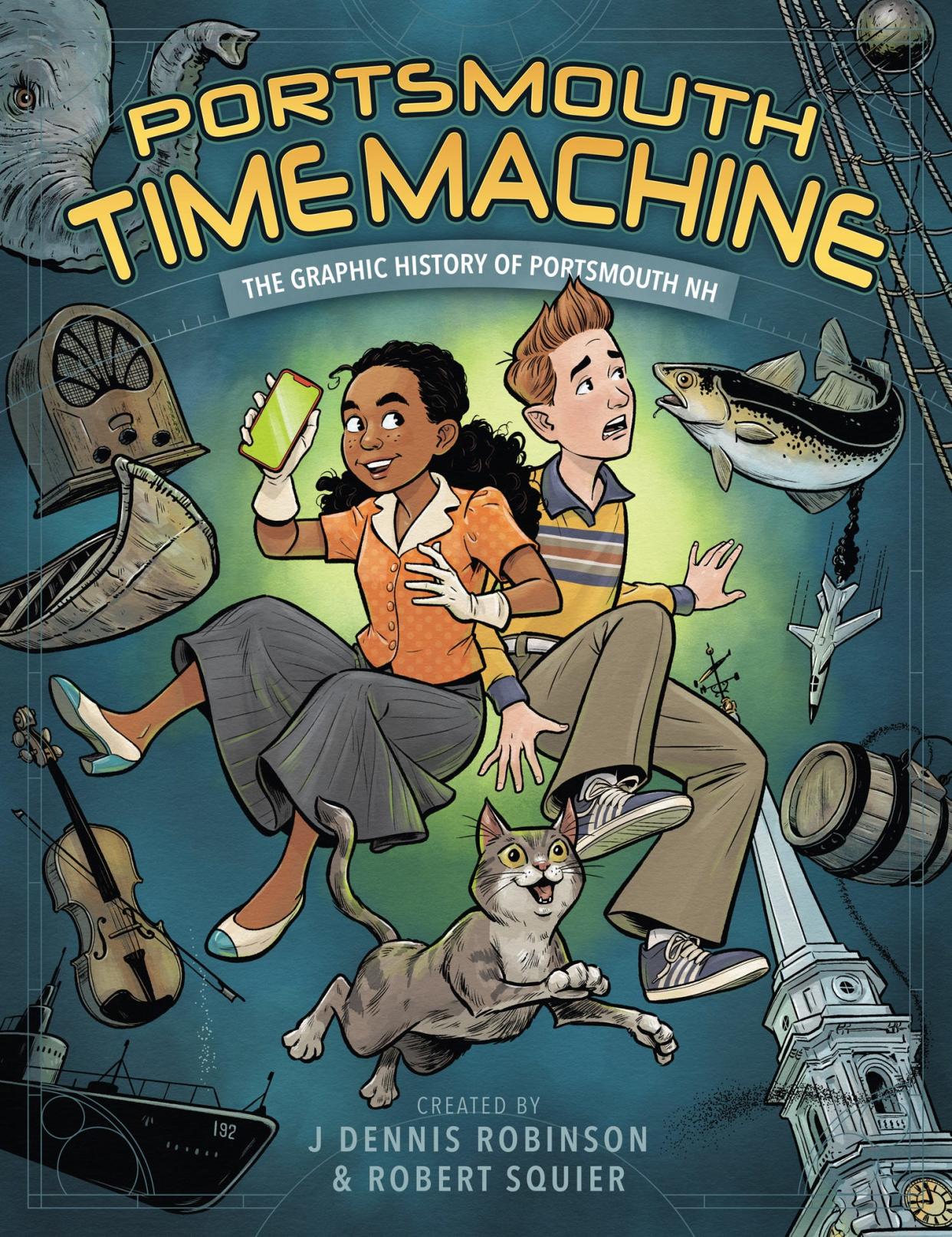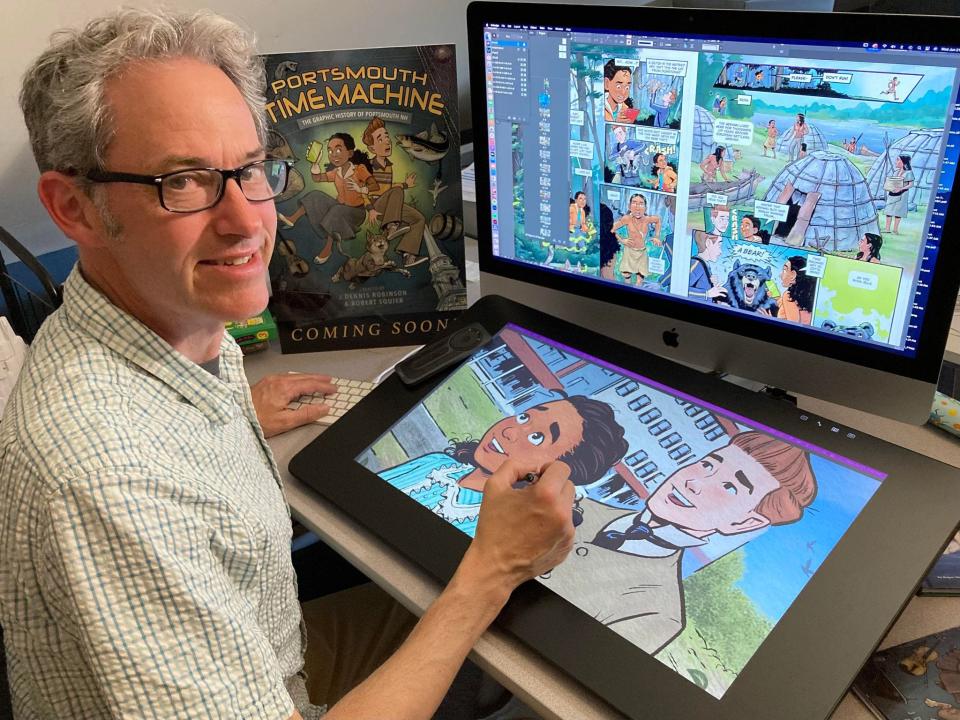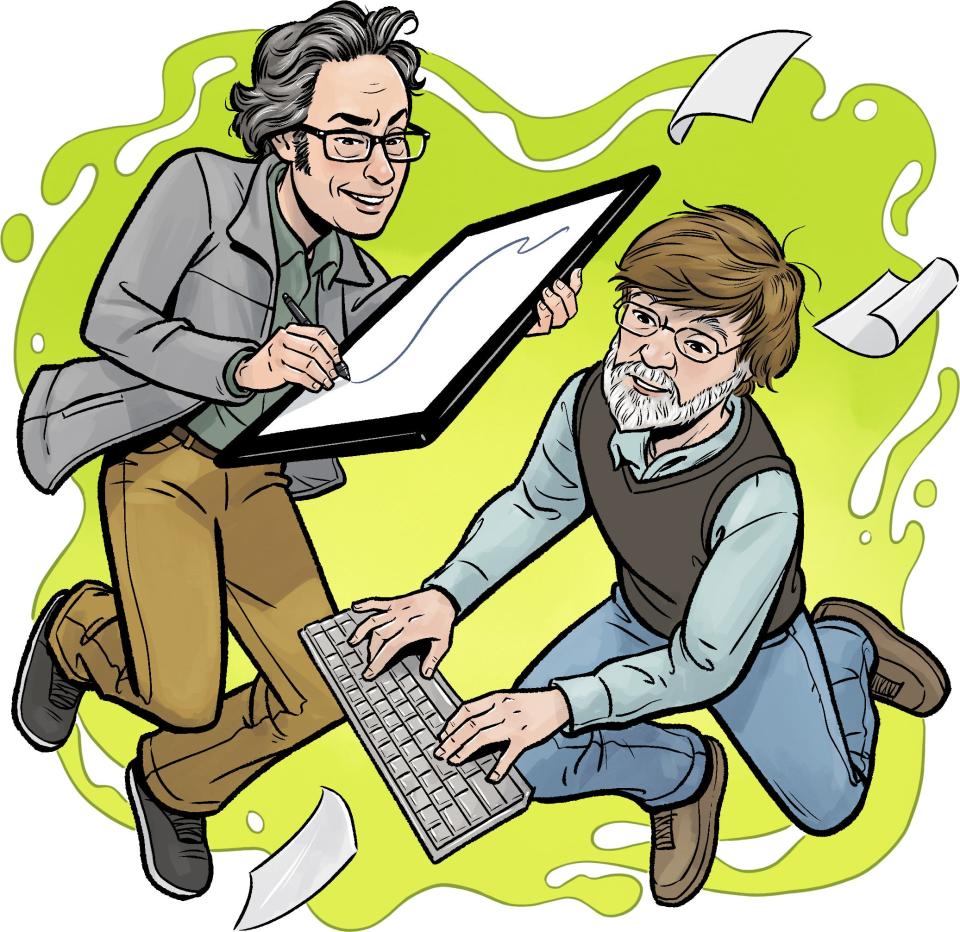The graphic life of Robert Squier. Illustrator creates 'Portsmouth Time Machine' comic.

Robert Squier and I aren't sure who suggested time travel. The idea of two kids catapulted through Portsmouth’s past due to a cell phone glitch just bubbled up. That was a year ago. With the city’s 400th anniversary looming, I was frustrated that no history of the city exists for kids. Robert’s son attends a local grammar school. His wife, Jessica, has a master’s degree in History. And lo, "Portsmouth Time Machine" was born.
“It’s going to be a ton of work,” I warned. Robert winced.
We both know how the freelance game works. I was editing my 15th history book. Robert was wrapping up illustrations on two Star Trek biographies for Penguin Workshop, a children’s book impression of Penguin Random House. To get our collaborative history comic published in time, however, we would have to go “indie.”
Portrait of a young artist

If I could draw like Robert Squier, I’d never write another word. Born at Exeter in 1968, there was art in his DNA. His great grandfather, Albert Squier, was a well known travel photographer. His grandfather, Donald Gordon Squier, a noted oil painter and portraitist, lived next door.
“Artist as an occupation was normal for me,” Robert says. His grandfather’s family portraits hung throughout their Exeter house. He frequently visited the studio that smelled of linseed oil and turpentine.
“I remember his wooden palette caked with dried paint,” Robert recalls. “It was like a colorful three-dimensional map.”
A passionate fan of Godzilla and battling “kaiju” monsters, the artist says “no special talent was evident” in his early drawings. Like countless cartoon nerds, he clipped Spider-Man from the daily newspaper and assembled his own comic books. "How to Draw the Marvel Way" by Stan Lee and John Buscema introduced him to perspective and composition. Mad Magazine artists Jack Davis and Mort Drucker were his virtual caricature instructors. Dean Scott was his real life art teacher at Exeter High, and they still keep in touch.
Learning curves

Although he studied graphic design at Maine College of Art, Robert was drawn to painting and the works of Cezanne, Van Gogh and Austrian Expressionist Egon Schiele. Raised in a suburban family of five boys – mother Theresa, father Donald – the young Squier now discovered the wild underground work of R. Crumb and the graphic novels of Art Spiegelman.
While taking classes at UNH, Robert launched a comic strip satirizing college drinking culture that appeared in the school newspaper. “It caused quite a stir,” he says today, but earned kudos from a Boston tabloid dedicated to promoting editorial cartoons.
In the mid-80s he hung out at Portsmouth’s iconic Elvis Room and worked, of course, at Comic Relief on Bridge Street. This was the era when the "Teenage Mutant Ninja Turtles," a comic book created in Dover, New Hampshire, hit worldwide domination. Robert sorted tons of independent wannabe comic classics with titles like "Elfquest," "Cerebus the Aardvark," "Flaming Carrot" and "Usagi Yojimbo." Owner Ralph DiBernardo now runs Jetpack Comics & Games in Rochester.
By the early '90s, the artist-in-waiting was living in Portsmouth, splitting rent on a spacious downtown apartment at $650 per month. He began picking up freelance assignments–logos, T-shirts, posters (Including the logo for my first history website in 1997). Computers were turning the publishing business inside out. To survive, graphic artists had to master the painful learning curve of software packages like Photoshop and QuarkXPress. Robert supplemented his income working at Market Basket. Eventually he landed a full-time gig in the growing field of Web design for a company named Velecom, later Harbour Light.
The Portsmouth cultural renaissance was in full swing with trendy coffee shops, designer brewpubs, and local galleries blossoming across town. Ironically, the artist met his future wife Jessica, then a guide at Strawbery Banke Museum, in a traditional ballroom dance class. She worked at Mystic Seaport in Connecticut, at Plimoth Plantation in Massachusetts, and for the Newport Historical Society in Rhode Island, before settling in Portsmouth.
From a bedroom studio, through an agent, Robert began picking up book illustration assignments. Projects came in from publishers like Child's World, Picture Window Books, Capstone, and Heinemann. His monthly column illustrating dinosaurs for Highlights Magazine ran for years.
Initially illustrations were done in watercolor and the finished art was mailed to the publisher by Federal Express. The artist would stress out, waiting on pins and needles for word that the artwork had arrived undamaged. The process has evolved to “painting” on a Wacom drawing tablet and downloading around the world in seconds.
“It took a long time to make my digital art not look like digital art,” Robert says. “My background in traditional painting helped me bridge that gap.”
When their son was born, Robert transitioned to a stay-at-home dad. But as the boy grew, he says, there was time again for illustration work. "Who Was Davy Crockett?" − his first book for Penguin (then Grosset & Dunlap) − kicked off a popular series. Other Squier-illustrated titles focused on Louis Braille, Frederick Douglass, the Wizard of Oz, Alice in Wonderland, Temple Grandin, Confucius, and recently–Captain Kirk and Captain Picard.
Inside the time machine
“Having a son helped me better understand how books are read–what kids respond to, and what works for a child and at what age,” Robert says. “For example, there’s a point where kids transition from board books to picture books to chapter books and graphic novels.”
The “Covid craziness” slowed his freelance work, but projects trickled in. Working from home was nothing new for artists and writers. Which brings us back to 2022. Robert and I met in person only a couple of times to brainstorm the shape of "Portsmouth Time Machine." The rest was all virtual.
“Here’s my sketch of the scene where the kids meet John Paul Jones,” I’d say in an email. Attached to wisps of dialogue, Robert would get my stick figure drawings that looked like something scratched on an Egyptian tomb. I sent tons of photos and historic images via Dropbox. A day or two later, the first fleshed out drawings would appear. It was like a Vulcan mind meld.
Cramming the history of Portsmouth into 32-pages was no easy task. My goal as the author, editor, art director, and publisher, was to make the most of Robert’s limited time and unlimited talent. Our protagonists, Ella and Seth and an unnamed tabby cat, time warp from an Abenaki village to the city’s 500th anniversary in 2123.
Our time travelers visit the founding English settlement in 1623, join the 1774 “powder raid” at New Castle, fight 19th-century fires, rescue the crew of the USS Squalus, help negotiate the Russo-Japanese peace treaty, and much more. Bonus pages feature Black history, women’s history, and a walking tour map of the city’s historic downtown sites. A companion website includes free guides for educators and young readers at PortsmouthTimeMachine.com.
“Working with Dennis for a year has been a living hell–and you can quote me!” Robert says with his signature shy laugh. “Just kidding, of course.”
“You were right,” he adds.”PTM was a lot of work, but a worthy and important project. It stretched my abilities and utilized all my skills. I'm very proud of the results.”
Those results would not have been possible without the generous support of our sponsors. They include the New Hampshire Charitable Foundation, PortsmouthNH400, Inc, Portsmouth Historical Society, Portsmouth Brewery, The McSharry Family, Rye Historical Society, and Prescott Park Arts Festival. Denise Wheeler, a Rye teacher and “Minister of Fun” for the city’s 400th celebration, was our prime mover.
In a rare moment the writer and illustrator will appear in the same space-time continuum on June 28 at the Portsmouth Historical Society, 10 Middle Street. Signed copies will be available for sale to benefit the society starting at 5:30 pm, with candid remarks and a few slides by the creators starting around 6 p.m. For more information visit PortsmouthHistory.org or call 603-436-8433 for reservations and information.
Copyright 2023 by the author. All rights reserved.
J. Dennis Robinson’s new books include "New Castle: New Hampshire’s Oldest, Smallest, and Only Island Town." A hardcover with 200 illustrations, it will be released next month. His myth-busting study of how NH really began in 1623 is due in September. Follow his latest projects on jdennisrobinson.com.
This article originally appeared on Portsmouth Herald: Graphic life of Robert Squier, 'Portsmouth Time Machine' illustrator

